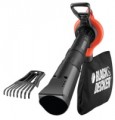Operating mode
Operating modes provided in the design of the garden vacuum cleaner. Many models support more than one mode. Also note that, despite the common name "garden vacuum cleaners", not all units are capable of suction.
—
Blowing out. This mode can be called “vacuum cleaner in reverse”: the device generates a powerful air stream, which can be used, for example, to remove debris from hard-to-reach places, or “sweep” garden paths.
—
Suction. The classic mode of operation of the vacuum cleaner: drawing in air along with various debris that is sent to the bin. Suction is well suited for "uncomplicated" debris — leaves and small chips.
—
Shredding. This mode of operation is similar to the suction described above, however, the garbage drawn in by the vacuum cleaner is not immediately sent to the bin (or “to the exit”, into an external container), but is preliminarily crushed. The meaning of this function is twofold: firstly, due to crushing, the volume occupied by garbage is significantly reduced (see “Chopping factor”), and secondly, recycled leaves and branches can serve as fertilizer.
Max. air flow rate
The highest speed of the air stream given out by the vacuum cleaner. The
higher this parameter, the stronger the thrust provided by the device, and the more efficiently it is able to pull or blow out debris particles from cracks and other hard-to-reach places (of course, if there is an appropriate operating mode — see above). At the same time, in most modern models, this figure exceeds 150 km/h — this is more than enough for work of small and medium complexity. Therefore, paying attention to a high flow rate makes sense only when choosing a powerful model for working in difficult conditions; we note that in the most “high-speed” vacuum cleaners, the indicators can exceed 400 km/h.
Air flow (suction)
Performance of the garden vacuum cleaner when working on suction (see "Operating mode").
As with blowing described above, this parameter primarily characterizes how large the area covers the vacuum cleaner when working:
high performance means that the device captures more air and draws debris from a larger surface. But this indicator is weakly related to suction efficiency: the ability of a vacuum cleaner to “pull out” debris particles from cracks, thick grass, etc. depends primarily on speed characteristics, not performance.
Mulching ratio
The ratio of shredding debris provided by a vacuum cleaner with the appropriate mode of operation (see above).
This parameter shows how much the volume occupied by garbage decreases after passing through the grinder. For example, the value "8:1" corresponds to a reduction of 8 times. These figures, of course, are quite approximate, because. in fact, much depends on the type of waste, and in different cases, the indicators will also be different. For example, bulky large branches are “packed” very tightly, and soft leaves initially take up relatively little space, and for them the difference in volume before and after the chopper may be small. Nevertheless, the claimed values quite reliably describe the capabilities of the vacuum cleaner for processing the collected garbage.
Garden vacuum cleaners with a grinding ratio of 1:10 can be classified as average; lower rates are typical for relatively modest models, larger ones for advanced ones.
Garbage container volume
The volume of the garbage collector — a container for garbage — regularly supplied with a garden vacuum cleaner. The larger the bin, the more debris can fit inside and the less often you have to empty it during work. On the other hand, a capacious container has the appropriate dimensions, and when filled, it also weighs a lot, which can affect the ease of use of the vacuum cleaner (this is especially true for manual and backpack models, see "Type"). Therefore, manufacturers tend to choose bins for their products based on the overall level of the vacuum cleaner and the scale of work for which it is designed. And some units may not be equipped with complete containers at all — in the expectation that the user picks up such a container separately.
The volume of the garbage can can be approximately estimated, knowing that an ordinary household bucket holds about 10 – 12 liters. Thus, for example, a 35 liter container corresponds approximately to three standard buckets.
Noise level
The noise level generated by the vacuum cleaner during normal operation. The lower this indicator, the more comfortable it is to work with the unit, the less the operator gets tired; and high noise levels may require the use of protection (e.g. earmuffs).
When assessing the noise level, note that the decibel used to measure this level is a non-linear quantity. Therefore, it is easiest to evaluate specific values using comparative tables. Here is one of the variants of such a table (rather simplified):
— 60 dB — sound comparable to a TV at medium volume. From this value, the indicators of modern garden vacuum cleaners begin, because. this technique works quite loudly.
— 70 dB — to a truck at a distance of about 8 m;
— 80 dB — traffic noise on a busy street;
— 90 dB — freight train noise at a distance of 8 – 10 m;
— 100 dB — the noise of the demolition hammer;
— 110 dB — indoor rock concert
Weight
The total weight of the garden vacuum cleaner. Usually, this paragraph indicates the "net" weight of the unit — with an empty dust container (or even without a dust container at all), without fuel and oil (in models with an internal combustion engine, see "Engine type"), without a battery (in the corresponding devices, also see "Engine type"), etc. This parameter is important primarily for models designed to
be carried "on oneself" — that is, hand-held and knapsack (see "Type").

